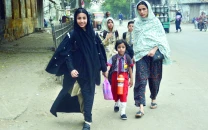3 humanitarian causes that Met Gala's $26 million proceeds could have helped
Here's where that money could have been better spent
-(1)1715249734-0/metgalacas-(1)-(1)1715249734-0-640x480.webp)
The Met Gala, known for its extravagant fashion and star-studded guest list, has once again made headlines, this time for its unprecedented surge in ticket prices. Entry to the exclusive event, held annually at the Metropolitan Museum of Art in New York City, now comes with a hefty price tag of $75,000 per individual ticket for the year 2024, as per Financial Express. This marks a significant increase from the $50,000 price tag in 2023, reflecting the growing allure and exclusivity of the event.
The event has evolved from its modest beginnings in 1995 when individual tickets were priced at a mere $1,000. In addition to the steep individual ticket prices, guests also incur substantial expenses when booking tables at the gala. Prices for a 10-seater table start at an astounding $350,000. Despite the steep price points, the New York Times reported that the event raised approximately $26 million, marking a $4 million increase over last year's total.
“There are very few other events that raise this kind of money,” said Rachel Feinberg, a fund-raising consultant who has worked on galas in New York City. Indeed - there are few instances that could make the kind of splash that the Met Gala does, all while being financially feasible. And yet, the proceeds seem to not make their way to terrorised, oppressed zones in need of liberation and aid. Here's where that money could have been better spent:
Palestine
As per CNN, the United Nations estimated that Palestinians need more than $1.2 billion in urgent humanitarian relief, with more than 90% of that for Gaza residents. As of January 2024, just over half of the required emergency funding had been provided. A data chart provided by CNN clearly shows all the areas where the Met Gala proceeds could have been put to use, hypothetically making leaps and bounds in areas such as food security and protection.
Sudan and South Sudan
The conflict between the Sudanese Armed Forces and Rapid Support Forces has elevated Sudan to the forefront of the 2024 Emergency Watchlist, pushing the nation perilously close to collapse. In less than a year of conflict, the number of people requiring humanitarian assistance has more than doubled.
In Darfur, reports from human rights organizations indicate widespread mass killings and forced displacement based on ethnic divisions. The situation is anticipated to deteriorate significantly, leaving millions without adequate food and unable to reach essential healthcare and other vital services.
Furthermore, since gaining independence from Khartoum in 2011, South Sudan has been plagued by insecurity. As the conflict across the border in Sudan escalates, there are growing concerns that it could further destabilize South Sudan's delicate economy and exacerbate political tensions. Additionally, the country is grappling with an economic crisis and heightened flooding, which are adversely affecting families' ability to access food. Presently, a staggering 9 million people in South Sudan require humanitarian aid, which translates to 72% of the population.
Democratic Republic of the Congo
In 2023, violent clashes erupted in the eastern region of the Democratic Republic of the Congo (DRC) following the breakdown of a ceasefire between the government and the M23 armed group. This intensified an already prolonged crisis, exposing millions of Congolese to conflict, political tensions, economic hardships, climate-related disasters, and recurring disease outbreaks. As the country enters 2024, it faces the daunting task of providing humanitarian assistance to 25.4 million people—surpassing any other nation in terms of humanitarian need, as per the International Rescue Committee's 2023 report.
The severity of the crisis has overwhelmed services, leading to heightened levels of food insecurity and contributing to the spread of illnesses. Additionally, insufficient humanitarian funding and widespread insecurity have hindered efforts by aid workers to reach communities in need.
These three pertinent global causes are simply the tip of the iceberg as far as humanitarian crises go. The International Rescue Committee contains a detailed report of devastating crises that must be paid heed to, yet go unnoticed. A bleak sense of media responsibility and even bleaker forms of reporting further rub salt in the open, festering wounds of such causes.
As we struggle to come to terms with this dystopian reality that we are a part of, where a small percentage flaunts its wealth in shamefully extravagant ways while a vast majority struggles to afford a single meal, one can only pray that this has all been a nightmare from which we must collectively jolt awake.
Have something to add? Share it in the comments



















COMMENTS
Comments are moderated and generally will be posted if they are on-topic and not abusive.
For more information, please see our Comments FAQ